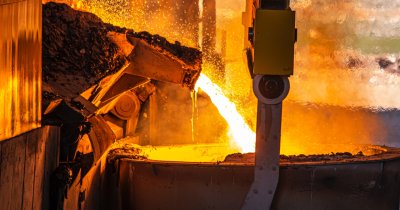European countries such as Germany, Spain and the Netherlands are already investing significantly in research and development, ahead of the moment when cultivated meat will reach final consumers.
From 2015 until today, more than 150 companies – mostly startups – have appeared globally on 6 continents, and have invested a total of about 2.8 billion dollars in research and testing.
For its part, the European Union has invested €25 million in funding for research into sustainable proteins including cultivated meat, and has confirmed that the EU Novel Food Regulation will be used to assess authorisation applications from companies.
Contrary to the international trend, in Romania, the Parliament is getting ready to ban cultivated meat, despite an obligation to comply with EU regulations, and before the Romanian public can make an informed choice.
Last October, parliamentarians in the Senate voted favourably on a project to ban the production and marketing of cultivated meat, and a final vote in the Chamber of Deputies is expected this spring. The adoption of the law may in the future attract infringement proceedings from the EU, for violating the principle of free movement of goods within the EU space. The ensuing financial consequences would also reflect on taxpayers.
The NGO and think tank Good Food Institute Europe (GFI) is one of the organisations working across Europe to support the development of accessible alternative proteins to mitigate the negative impact of industrial animal farming.
"Cultivated meat not only holds the potential to significantly enhance Romania's food security and create future-proof jobs but also empowers consumers with an increased range of choices and freedom to purchase sustainable food”, claims Seth Roberts, Policy Manager at the Good Food Institute Europe.
Amidst a lack of clear information, misinformation surrounding cultivated meat, often misleadingly dubbed "artificial meat," has proliferated in the public discourse. Recognising the importance of dispelling misconceptions and providing precise details about a potential solution to global issues like food security, pollution, and public health risks, we offer a compilation of data derived from scientific sources and studies.
What is cultivated meat and how is it produced?
Cultivated meat is the same as the meat we eat today but made in a different way. It is produced by taking a small sample of cells from an animal, through a procedure that doesn’t require the slaughter of animals.
Animal cells are placed in a cultivator, a sterile and controlled environment, which mimics the growth processes that happen inside the body of animals. Here, cells receive nutrients that allow them to grow, including amino acids, vitamins, glucose, inorganic salts, growth factors, and other proteins.
One of the biggest challenges today is the creation of cultivators with large enough capacity for mass production that ensure growth under optimal and sterile conditions.
According to Professor Petru Alexe, former Dean of the Food Science and Engineering Faculty at the „Dunărea de Jos” University in Galați, „for cultivated meat, the cells extracted from the animal are cultivated in an external environment and multiplied. The nutritional value of this type of meat is very good – it is a scientific success. Cultivated meat is a reality that must be considered and be allowed to evolve. Under no circumstances should it be banned because it is a valuable alternative food for mankind, and we should let consumers and the market determine its viability. But it is indisputably a very important scientific achievement, and we have no arguments to formally ban it.”
When will cultivated meat be available in stores?
Currently, multiple companies are trying to scale production, pending the necessary regulations. In Europe, there are companies working on everything from foie gras (Gourmey in France) to pork (Mewery in the Czech Republic) and fish (Bluu in Germany).
Singapore's Food Agency approved the first cultivated chicken meat product as early as December 2020, while in June 2023, two US companies received approval from the State Department of Agriculture for their cultivated chicken products.
In the EU, cultivated meat must go through the 18-month testing process applicable to all innovation-based products, during which a company must prove to the European Food Safety Authority (ESFA) that their product is safe for consumption.
No company has submitted a request in the European Union, but in July 2023, the first regulatory application in Europe was made to Swiss regulators by Aleph Farms, shortly followed by an application in the UK.
Italy, on the other hand, became the only country in the world to ban the production and marketing of cultivated meat last November. The decision was taken to protect culinary traditions, following a debate dominated by misinformation and without undertaking an evidence-based assessment.
The law has been criticised by the scientific community and environmental protection organisations as being in total contradiction with the trends and the global openness towards this new opportunity. Researchers fear the move could stifle innovation and academic funding while noting that it prevents Italian startups from flourishing in the country to the benefit of foreign companies. Should the EU approve the sale of cultivated meat products, in fact, Italy (like Romania if the ban goes ahead) would not be able to stop imports from other EU member states.
Meat without antibiotics and chemicals, enriched with healthy fats
Unlike intensively farmed meat, cultivated meat does not require antibiotics to control diseases caused by bacteria such as Salmonella, Campylobacter or E. coli.
This should reduce the alarming phenomenon of the transfer of antibiotics into the human body through the consumption of meat and of the development of antibiotic resistance, considered by the World Health Organization to be a global threat to public health.

The enriching of cultivated meat products with Omega 3 fatty acids and other healthy fats, which could reduce cholesterol and the risk of colon cancer associated with red meat consumption, is already being tested in Spain. Another advantage is that the sterile production environment of cultivated meat reduces the risk of bacterial contamination.
“An example we can use to illustrate the process behind cultivated meat is yogurt. When we put some organisms to reproduce in a controlled environment, we cultivate microorganisms (lactic acid bacteria), create the conditions for them to multiply in milk, and the result is an excellent product – but a new, artificial product. It's all about control and innovation. Cultivated meat is obtained in a strictly controlled environment, and therefore is safer when consumed quickly. But in time, solutions will likely be found for any such challenges that may arise”, adds Prof. Alexe of the Food Science & Engineering Faculty in Galați. Meanwhile, a rigorous study on the safety of consuming cultivated meat, published in 2023 by the UN FAO, showed the hazards of cell-based foods are the same as those found in other food manufacturing.
Solution for food security, reduced environmental impact & eliminated animal suffering
According to the latest projections, the global meat demand will increase by at least 50% by 2050. The world does not have enough land, water and other resources to satisfy this demand using conventional animal agriculture alone. Our current system of meat production is already driving 20% of global greenhouse gas emissions.
Cultivated meat can become an ecological alternative. According to the existing literature, compared to traditionally produced meat, cultivated meat can have a significantly lower environmental impact, requiring 90% less land, 94% less air pollution, and 92% less greenhouse gas emissions.
Many environmental organisations believe that alternative proteins will play a valuable role in reducing emissions by 2030, essential for keeping global warming below 1.5° C. This was also stressed by the UN Environmental Programme (UNEP) in a report presented at the COP28 in Dubai, which called for policymakers to support alternative proteins, including cultivated meat, to make food systems more sustainable, diversified and resilient.
According to Associate Professor Mălina Petrescu of the Faculty of Environmental Science & Engineering at Babeș-Bolyai University in Cluj-Napoca, „Romania faces increasing challenges from extreme weather events and agricultural pollution. To align with the EU's Green Deal, our focus should shift to establishing a more resilient and sustainable food system, especially when it comes to protein. Cultivated meat is a promising technology that can deliver the meat people want with significantly fewer resources. By funding open research and with the right policy support it can play a vital role in curbing the environmental impact of agriculture, which currently stands as the third-largest source of greenhouse gas emissions in Romania".
In our current agricultural system, there's room for positive change. Traditional farms, crucial for food production, face challenges like water and soil contamination and emissions of harmful gases. But cultivated meat can help to satisfy the growing demand for meat, reducing pressure on farmers to produce more food with fewer resources, and enabling them to farm sustainably.
Economic opportunities and a greater variety of choices for consumers
Currently, cultivated meat has a higher production cost than conventional meat, but technological and research advances could enable production at competitive prices in the next decade. Faced with an increased demand for meat worldwide, farmers can play a key role in the transition to alternative proteins, especially if supported by public policies to adapt and take advantage of new opportunities.
Cultivated meat gives them the opportunity to diversify, produce ingredients to feed cells or even provide high-quality cells. The German government has recently announced a 38 million fund dedicated to protein diversification, including funding to support farmers willing to shift to alternative protein production.
Cultivated meat can be produced by any company, big or small, but governments ought to fund open-source research to encourage independent producers and make room on this market for everyone.
Aware of the benefits to the planet, public health and farm animals, more and more people are looking forward to cultivated meat entering the commercial circuit. Prohibiting marketing based on considerations other than the product's safety for food consumption would unduly limit the consumer's right to choose, while in the case of Romania, a possible legal ban would conflict with EU legislation and bring forth economic consequences for taxpayers.
According to Seth Roberts of the Good Food Institute Europe, the development of forward-looking policies is crucial to capitalising on Romania's strong startup ecosystem and its strengths in biology, engineering, and natural sciences.
”Building confidence through consistent policy support will not only attract investments but also position Romania as a regional leader in the cultivated meat space, delivering economic benefits for innovators and consumers. It's crucial to learn from Italy's misstep in banning cultivated meat. Driven by misinformation, the decision violates single-market rules, threatens relationships with the EU, and jeopardises investments, consumer rights and scientific research – pitfalls that Romania must avoid at all costs”, he adds.
 Oana Coșman
Oana Coșman












Any thoughts?